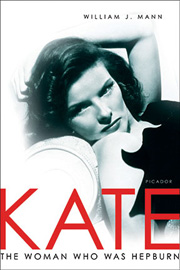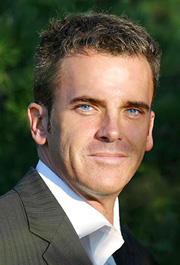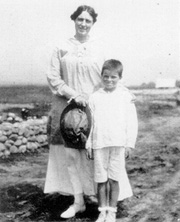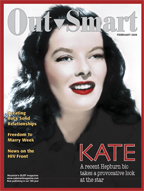The Not-So-Straight Kate
For OutSmart ‘s Valentine’s Day issue, I spoke with William Mann about his biography of Katharine Hepburn, whose legendary love affair with Spencer Tracy was as essential to her mystique as her appealing androgyny. In its review of Kate: The Woman Who Was Hepburn,Publishers Weekly describes Mann as “a skilled chronicler of gay Hollywood.” The reference is to Mann’s earlier books, one of which is Wisecracker: The Life and Times of William Haines, a biography of one of Hollywood’s biggest stars in the late 1920s and early 1930s. Haines’ historical significance may be his refusal to hide his homosexuality, which caused his studio to drop him, but launched a successful career as an interior designer. Mann also penned Edge of Midnight: The Life of John Schlesinger, a 2006 biography of the out director. (The photo of Mann shown below was taken by Michael Childers, widower of Schlesinger.)
 The research Mann did in preparation for the Haines biography overlapped into the life of his current subject, Katharine Hepburn. His emphasis in Kate is not on her long career, but on her personal relationships. Though some accuse Mann of searching for sexual ambiguity where there is none—because of his own homosexuality—his reviewers overwhelmingly find his work careful, thoughtful, and open-minded.
The research Mann did in preparation for the Haines biography overlapped into the life of his current subject, Katharine Hepburn. His emphasis in Kate is not on her long career, but on her personal relationships. Though some accuse Mann of searching for sexual ambiguity where there is none—because of his own homosexuality—his reviewers overwhelmingly find his work careful, thoughtful, and open-minded.
Mann spoke to me by phone from his home in Palm Springs, California.
Blase DiStefano: How about if we start with how you became aware of the elephant in the room, so to speak—Hepburn’s sexuality.
William Mann: I had previously done quite a bit of research in Hollywood working with and getting to know a number of the survivors of the studio era and, in particular, some very close friends and associates of George Cukor, who had been Hepburn’s mentor and her good friend. And so I knew there was another side to her. There were stories that had never been told, because, of course, these were men and women who knew her privately. I was just struck at her death how there was such an outpouring of affection for her, and I thought, This is a woman who really made herself into a symbol of the American character in so many ways. It was a fascinating life, because she was able to create such a legend around herself, and I thought maybe the full story might prove to be even more fascinating.
About her visits to her aunts in Greenwich Village…how might those visits have colored her life?

I think they were very important. Hepburn grew up in a very unorthodox, bohemian family. Her mother was a separatist who later championed legalized birth control. Her father was a radical physician working on treating venereal disease. So she grew up in a family where they were always challenging each other politically, intellectually, socially, culturally. So going into New York with her mother, going to those feminist meetings in Greenwich Village truly must have imprinted upon her an idea that one defined one’s self and one’s life based on what was right for them rather than trying to fit into conventional norms. And that’s certainly what she did with her own life.
Who was Jimmy, and how did he come about?
Jimmy was the name that Kate gave to her child alter ego. She really felt more comfortable living as a boy, as many girls do as part of the tomboy tradition. But in so many ways she would refer to Jimmy all her life, which told me that he never really left. One of her friends from The Oxford School back in Hartford said to me, “We all were like that, but we grew out of it. She never did.” I think she often thought of herself as a man. She often used male pronouns when she was describing herself. She might say, “I’m the best guy to do the job” or “I’m the man who takes care of things.” She referred to herself as a man and thought and really interacted in the world like a man would. I think that’s so important to understand about her—that this inner self of hers was Jimmy. Jimmy really lasted all her life. And I think Jimmy was the most real personification of Katharine Hepburn.
What was going on when she said she didn’t believe in male homosexuality?
That’s completely disingenuous. She knew there was such a thing. She’d always known gay men. But I think in that situation, she may have been playing a little bit with the notion of “If I don’t see it, it doesn’t exist.” Of course, remember who she said it to was Garson Kanin, who was a deeply closeted gay man. They were sitting with Spencer Tracy, who wrestled with his own sexual conflicts. I think if she was able to say in their presence, “I don’t know about it. I’ve never heard of it,” it was her way of pushing it away from her.
On the other hand, the remark came from Garson Kanin, who put it out there at a time when the gay movement was just coming into the national headlines, and I think he had his own reasons for making sure that any of that kind of sexual ambiguity was distanced from Hepburn. He was removing her from that, because he was going to write a book that celebrated the great love of Kate and Spence. So there was a lot of disingenuousness around that comment.
 Jimmy was a straight man, and the stereotypical straight man doesn’t want that male-homosexuality thing in his face, so to speak.
Jimmy was a straight man, and the stereotypical straight man doesn’t want that male-homosexuality thing in his face, so to speak.
Yes, there was always a discomfort with overt male sexuality on her part, whether that means with men or with women, but particularly homosexuality. She had never had a problem with lesbians. They were always around her, and she knew many lesbians who were in committed relationships. Very mannish, very traditionally stereotypical butch lesbians were always around her. But she was very uncomfortable with very effeminate gay men. And that was as a straight man, as you say. If she viewed the world as a heterosexual man in many ways, overt or flamboyant homosexuality was going to be uncomfortable for her, whereas a lesbian was not going to be as threatening.
In 1921, Hepburn’s brother Tom committed suicide. Is there any evidence to show that it may have been because he was gay?
Well, as I go into it in the book, I don’t call it suicide, because I don’t think we can say that for certain. In fact, the coroner’s report shows that he could have stopped what he was doing at any moment. He wasn’t hanging as people have long assumed. He actually had his neck bound with a sheet and it was tied to something across the room, so all he had to do was stand up if he didn’t want to die.
So I don’t think it was an accident, but neither does it seem like that would be the way one would commit suicide either. My guess is that he was experimenting with something. Perhaps trying a stunt. Perhaps it was auto-erotic asphyxiation. Who knows what he was trying to do in that moment. I do think he may have been sexually conflicted, and that’s really based on what Kate told to Scott Berg
. It fits with the kind of boy he was, and from what people remember about him; he was very anxious, very nervous. But I would certainly not go out on a limb and say that was why he took his life, because I’m not even sure he did intend to take his life.Do you think there was any lingering sadness about his death?
Oh absolutely, absolutely. It wasn’t dealt with. In the old kind of New England WASP tradition when someone died, it was, “We just move on. We don’t grieve. We don’t shed a lot of tears.” And that was the case with the Hepburns. I think that was very, very difficult for Kate, who found him. He was her idol. She was 13 or 14 when she found him, and I’m sure that left a real impact on her.
Hepburn’s first gay friend was Jack Clark. What was it that she liked so much about him?
I think like with all of her gay friends, she gravitated to men who were very cultured, very smart, very witty, who had connections, and who could be completely devoted to her. And that was the thing with her gay male friends. She could be the queen. They didn’t have wives or children they had to run home to. They could sit there at her feet and cater to her and laugh at her jokes and take her places. That was always the case with her best gay friends, and Jack Clark was the first one. And he was good friends with her husband. So it continued right through to the end of her life.
Her first love was Phelps Putnam. Would you say he had a fluid sexuality?
I’m not sure. I mean…there’s no evidence. But I do know he was madly in love with the painter Russell Chaney. Those letters do survive. So he certainly had a deep love for Chaney. And I think he also then fell deeply in love with Kate. So, on that level, yes, it seems fluid. I’m not sure how often he went back and forth. In fact, reading his works and his letters makes me think that he was often too drunk to do anything with anybody. Which of course is an early foreshadowing of Spencer Tracy.
And John Ford, right?
Right. They all seemed to be very, very similar in their sexuality and in their conflicts.
In 1930, Hepburn fell in love with Laura Harding. Can you tell me a little bit about that relationship?
Some people said she was the great love of her life…
Not-So-Straight Kate continued >>
Part 1 • 2 • 3












Comments